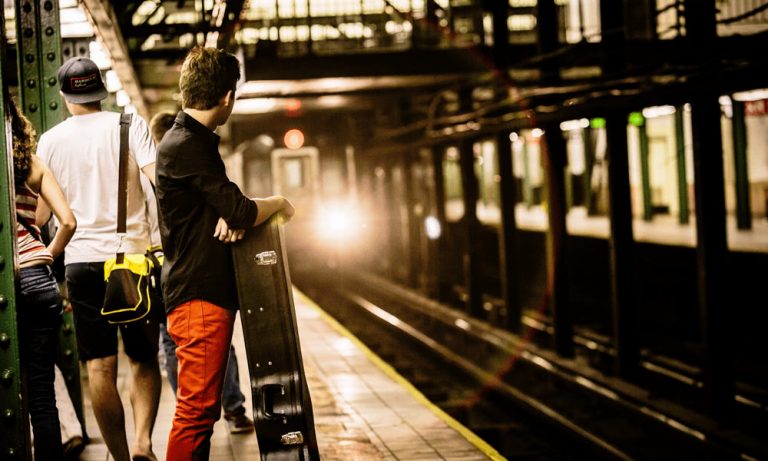Nestled within the beating hearts of our cities, street performers (or buskers) are a natural and integral element of the urban microcosm. For some, it’s away to play for their daily bread. To others, it’s a unique chance to experiment; an open (often one-sided) dialogue with society, a space to share, a paid rehearsal, and sometimes within a subway.
Whatever the course, it’s damn hard work and demands a particular resilience. If the pay-off is weak, it’s often a matter of picking up and relocating. But competition for coveted spots can be fierce, and there are no guarantees. Unlike more distinct music spaces where we might bear expectation, the city is, after all, the most public and unpredictable platform for performance.
And there’s perhaps no greater example of busking’s storied history than that of the New York City subway. While its relationship with authority has often been tenuous, an ease in policing, coupled with a rise in technology and the wider possibility of promotion, makes it an attractive proposition for the budding and veteran performer alike.
It’s a unique chance to experiment; an open dialogue with society, a space to share, a paid rehearsal
It’s to this sprawling, bustling transport network that hundreds of musicians and artists make daily pilgrimage, with instruments as varied as musical saw, kora, handpan, iPad, and any assortment of brass, percussion and woodwind. Their seeds of expression flow freely throughout its extensive arteries at all hours, spreading and pollinating a diversity of sound and culture among the swathes of commuters.

New York outfit Too Many Zooz pay tribute to the subway with their latest clip ‘Bedford’
Love Music?
Get your daily dose of metal, rock, indie, pop, and everything else in between.
Here, in the hallways and mezzanines of Grand Central Station, Union Station, and dozens more, performance permits aren’t required. MTA (The Metro Transportation Authority), the New York subway network’s governing body, even offers 350 coveted subway contracts through its Music Under New York program (MUNY).
You’d scarcely find a busier or more transient environment for sharing public art, with the whole system ferrying over 5 million passengers on an average weekday. There’s a beautiful, essential duality to it all, too – buskers intimately performing in subway confines to countless New Yorkers. For but a moment, they may touch the lives of any number, yet often remain as anonymous.
It’s not exactly anything goes, though. Beat cops are ultimately awkward arbiters of what constitutes art and busking. Amplification, too, is limited. For raucous three-piece Too Many Zooz, however, it’s hardly required (and with a name like that, it’s little wonder!).
THIS is how @TheRoots got their start….minus youtube to spread the quicker word. http://t.co/j6RUqyGhrz peep NYC’s own @TooManyZooz
— Questlove Gomez (@questlove) March 7, 2014
A shoutout from Questlove helped put the street performers on the map.
One of the biggest and brightest success stories to come from the New York subway, Too Many Zooz played together publicly every day for two years, testing, experimenting and refining their natural interplay until it became a career that would take them around the world – including their first visit to Australia next month.
Their infectious chemistry is as much informed by the improvised immediacy of the daily busk as it is their collected formal music education. Where some might have folded to the temptations of a more polished sound, Too Many Zooz let the primal elements seep through in their signature stomping brass-band-meets-EDM-beats blend.
Raucous bursts of Matt Doe’s trumpet punctuate the theatrics of Leo Pellegrino’s sax, whose playful baritone shrieks and gurgles are but a few of the sonic inflections in the musician’s bag of tricks. They let the metaphorical animals out of the cages, and break down the imagined (and only) barrier between busker and commuter.

From the New York subway, to the Royal Albert Hall
Within their punchy, exciting and involving energy are clear Cuban, Caribbean and Arabic influences, with the underlying restraint of house music’s rhythms keeping the beat. Their self-ascribed ‘brass-house’ sound, then, is a fitting moniker for their immediate and infectious cacophony.
So it’s to little surprise that they quickly built a strong following with fellow performers and commuters, before technology took them from the train platform to the global one. A 2014 Twitter shoutout from perennial favourite Questlove highlighted the New York spirit that flowed through every facet of the band, and was followed by a viral viewing of a Union Station performance. With the right eyes and ears taking notice, those plaudits carried them all the way to a highlight of working on Beyonce’s acclaimed Lemonade.
And, with the 2016 release of album Subway Gawdz and lead single ‘Bedford’, their ode to Bedford Ave Station, as well as frequent returns to their beloved New York subway, the trio haven’t stopped honouring their subway roots. A subway that, as recent figures from overseeing body MUNY would attest, is blossoming with an as yet-unseen popularity – its tight confines giving artists a truly global platform like no other.

































